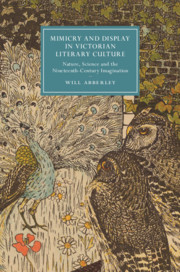 Mimicry and Display in Victorian Literary Culture
Mimicry and Display in Victorian Literary Culture Art, Nature and Science in Representations of Crypsis
Published online by Cambridge University Press: 16 May 2020
Chapter 1 argues that Victorian studies of animal mimicry and camouflage (known collectively as crypsis) resisted the hardening dichotomy between science and the arts. Researchers drew on their subjective perceptions, and art theories and techniques, to represent crypsis and recreate its illusions for readers. The first theorisers of ‘protective mimicry’, Henry Walter Bates and Alfred Russel Wallace, laced their writings with personal anecdotes of being deceived by animals’ appearances. Such narratives substituted for the imagined experiences of these animals’ predators and prey. It is proposed that these texts followed a pattern of perceptual self-scrutiny and suspended judgement that had been articulated by the art critic John Ruskin. Bates, Wallace and, even more, the Oxford zoologist Edward Bagnall Poulton also sought to simulate experiences of crypsis through illustrations. Accompanying text guided readers through the trompe l'oeil much as Ruskin’s ekphrastic prose guided the consumption of paintings. The tension between such artistic science and the rising ideal of objectivity came to a head in the controversial work of the American artist Abbott Handerson Thayer. Although Thayer made some lasting contributions to crypsis studies, his approach to nature as an artwork that only artists could understand provoked strong attacks from some zoologists.
To save this book to your Kindle, first ensure [email protected] is added to your Approved Personal Document E-mail List under your Personal Document Settings on the Manage Your Content and Devices page of your Amazon account. Then enter the ‘name’ part of your Kindle email address below. Find out more about saving to your Kindle.
Note you can select to save to either the @free.kindle.com or @kindle.com variations. ‘@free.kindle.com’ emails are free but can only be saved to your device when it is connected to wi-fi. ‘@kindle.com’ emails can be delivered even when you are not connected to wi-fi, but note that service fees apply.
Find out more about the Kindle Personal Document Service.
To save content items to your account, please confirm that you agree to abide by our usage policies. If this is the first time you use this feature, you will be asked to authorise Cambridge Core to connect with your account. Find out more about saving content to Dropbox.
To save content items to your account, please confirm that you agree to abide by our usage policies. If this is the first time you use this feature, you will be asked to authorise Cambridge Core to connect with your account. Find out more about saving content to Google Drive.